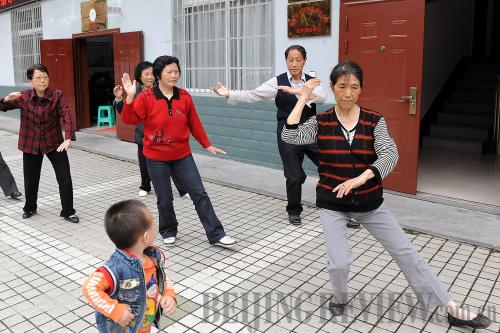|
 |
|
KEEPING FIT: Residents practice taiji in a residential compound in Ankang, north China's Shanxi Province, May 27 (HE JUNCHANG) |
Already in her 80s, Fang Wenqi is not a tech-savvy person, yet she is using the cutting-edge technology known as the Internet of Things to monitor her health.
Fang, a resident in Beijing's Haidian District, suffers from hypertension and cardiovascular disease. Thanks to a "black box," a remote monitoring device, she can have doctors check her blood pressure and pulse without leaving her home. The data are transmitted to doctors in a nearby community health center, and stored in her personal medical record.
Her family doctor in the community health center will analyze the data and if they are not within the normal range, the doctor will call her and give her suggestions on how to adjust medication and treatment. The doctor will also let her know if further medical examination is necessary.
"Previously, I had to go to hospital very often. Now it is very convenient," Fang said.
A 75-year-old diabetes patient surnamed Cao in Yuejiyuan community in Haidian also has a remote monitoring device at home. He uses the handheld device to monitor his blood sugar level.
The device is easy to operate. After connecting it to a cellphone customized for elderly people, Cao can select a time interval from four available choices in the phone's menu: before a meal, two hours after a meal, after taking medication or anytime he feels uncomfortable. Collected blood sugar data can be transmitted instantly to a community health center for timely feedback.
Both Fang and Cao are beneficiaries of Haidian's pilot program using the Internet of Things in the prevention and management of chronic diseases, the first of its kind in the country.
A country with a higher incidence of chronic diseases, China does need more such programs.
More than 260 million Chinese people suffer from chronic diseases, which lead to about 85 percent of all deaths in the country, according to data released by the Ministry of Health on July 9.
An earlier report released by the China Heart Congress even estimated that the number of people aged 40 and older with chronic diseases in the country would double or even triple by 2030.
Cardiovascular diseases, malignant tumors, diabetes and respiratory diseases are the major chronic diseases that affect the health of Chinese, said Kong Lingzhi, Deputy Director of the Department of Diseases Prevention and Control under the Ministry of Health.
Kong said that rapid industrialization, urbanization and an aging population mean the number of the country's patients with chronic diseases has been rising continually and quickly. Chronic diseases have placed heavy pressure on the healthcare system, as such cases account for 70 percent of the total medical bills.
To address the problem, 15 central government departments including the Ministry of Health released the 2012-15 Blueprint on Chronic Disease Prevention and Control in May.
The blueprint, the first national plan of its kind, sets the goal of extending the average life expectancy of the population by one year in the next three years.
To implement the blueprint, the Ministry of Health has taken a number of measures including monitoring risk factors and indicators of chronic diseases.
Establishing the monitoring and information management system for chronic diseases is one of the priorities on the agenda of the Ministry of Health, Kong said.
"When Internet of Things technology is applied to community-based medical services, patients with minor ailments, chronic diseases and common illnesses can be served by nearby community medical facilities, which can reduce unnecessary visits to large hospitals and save money for both patients and the government," said Mao Yu, Deputy Director of Beijing Health Bureau.
In China, people tend to flock to large hospitals even for minor ailments. As a result, large hospitals are chronically packed, whereas community health centers are underused. In large hospitals, patients usually have to stand in long lines and wait for half a day for their turn to meet the doctor.
| 